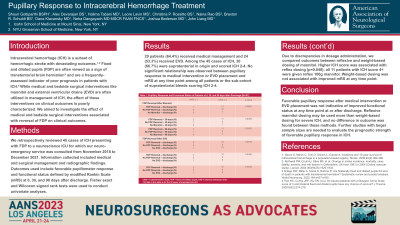The Effect of Pupillary Response after Medical Intervention or EVD Placement on Clinical Prognosis in Patients with Intracerebral Hemorrhage
The Effect of Pupillary Response After Medical Intervention or EVD Placement on Clinical Prognosis in Patients with Intracerebral Hemorrhage
Friday, April 21, 2023


Shouri V. Gottiparthi, BSPH (he/him/his)
Medical Student
Icahn School of Medicine at Mount Sinai
ePoster Presenter(s)
Introduction: Fixed and dilated pupils (FDP) are frequently-assessed indicators of poor prognosis in patients with intracerebral hemorrhage (ICH). While medical and bedside surgical interventions like mannitol and external ventricular drains (EVD) are often utilized in ICH management, the effect of these interventions on clinical outcomes is poorly characterized. We aimed to investigate the effect of medical and bedside surgical interventions associated with FDP reversal on clinical outcomes.
Methods: We retrospectively reviewed 45 ICH cases presenting with FDP to a neuroscience ICU for which our neuroemergency service was consulted from November 2018 to December 2021. Medical and surgical management and radiographic findings were collected. Outcomes include favorable pupillary response and functional status defined by modified Rankin Scale (mRS) at 0, 30, and 90 day follow-up. Fisher exact and Wilcoxon signed rank tests were used to conduct univariate analyses.
Results: 29 patients received medical management, 17 of whom (58.6%) had favorable pupillary response. 24 received EVD, 16 of whom (66.7%) had a favorable response. No significant relationship was observed between pupillary change following either intervention and mRS at any time point. Given discrepancies in administration, we compared outcomes between reflexive and weight-based mannitol dosing. Higher ICH score was associated with reflex dosing (p=0.048); all 11 patients with ICH score 4+ were given reflex 100g mannitol. Weight-based dosing was not associated with improved mRS at any time point. 3 of 13 patients (23.1%) without favorable pupillary response after medical intervention exhibited mRS < 3 90 days after discharge.
Conclusion : Favorable pupillary response frequently followed medical intervention and EVD placement, but did not indicate improved functional status. Reflexive mannitol dosing may be used more than weight-based dosing for severe ICH, and no difference in outcome was found between these methods. Further studies with larger sample sizes are needed to evaluate prognostic strength of favorable pupillary response in ICH.
Methods: We retrospectively reviewed 45 ICH cases presenting with FDP to a neuroscience ICU for which our neuroemergency service was consulted from November 2018 to December 2021. Medical and surgical management and radiographic findings were collected. Outcomes include favorable pupillary response and functional status defined by modified Rankin Scale (mRS) at 0, 30, and 90 day follow-up. Fisher exact and Wilcoxon signed rank tests were used to conduct univariate analyses.
Results: 29 patients received medical management, 17 of whom (58.6%) had favorable pupillary response. 24 received EVD, 16 of whom (66.7%) had a favorable response. No significant relationship was observed between pupillary change following either intervention and mRS at any time point. Given discrepancies in administration, we compared outcomes between reflexive and weight-based mannitol dosing. Higher ICH score was associated with reflex dosing (p=0.048); all 11 patients with ICH score 4+ were given reflex 100g mannitol. Weight-based dosing was not associated with improved mRS at any time point. 3 of 13 patients (23.1%) without favorable pupillary response after medical intervention exhibited mRS < 3 90 days after discharge.
Conclusion : Favorable pupillary response frequently followed medical intervention and EVD placement, but did not indicate improved functional status. Reflexive mannitol dosing may be used more than weight-based dosing for severe ICH, and no difference in outcome was found between these methods. Further studies with larger sample sizes are needed to evaluate prognostic strength of favorable pupillary response in ICH.
